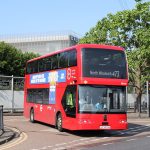The UK’s first zero-emission coach is Yutong’s TCe12. We put it to the test in the urban jungle and on the motorway

One of the most significant recent developments for the UK coach market has been the debut of its first zero-emission vehicle. The honour went to Yutong for its TCe12, a low-height model with 258kW/h of battery capacity.
Westway Coach Services is the first buyer of the TCe12 here. It has ordered three, two of which have arrived from China. Supplier Pelican Bus and Coach has another two on the way: One for a Scottish customer and one as a demonstrator.
The TCe12’s batteries and driveline are identical to those in Yutong’s electric buses, although the coach’s axle ratio is adjusted. That should deliver reassurance to buyers; tens of thousands of Yutong electric buses are in service globally.
Westway’s first TCe12 has driven interest in the concept. Although its height of 3.40m means gives moderate luggage capacity, the operator has specified a trim level that suits numerous duties.
The TCe12’s zero-emission nature is also attractive to some groups. Pelican says all the enquiries it has received so far are from operators that have clients willing to pay a premium to travel in such a coach.
Clearly, the TCe12 is not aimed at long-distance applications. Its practical range, based on a calculation of distance covered and power consumed, is likely to be around 200 miles.
Where it comes into its own is in usage profiles such as Westway’s, where mileages can be modest. Add to that a much lower energy cost than for a diesel, and the £305,000 retail price could stack up when taken as part of a wider TCO equation.
Whether the TCe12 marks the start of a move towards zero emission in the coach industry remains to be seen. Nevertheless, its coming is a major event. routeone was the first UK publication to put the type through its paces thanks to Westway making its second TCe12 available for a Test Drive.
The nuts and bolts
The TCe12 has a wide nearside centre door and thus one application that it suits is where rapid boarding and alighting is key. A lift can be positioned within the centre steps.

Westway’s two TCe12s were delivered with 45 seats. Their capacity has since been increased to 49. Underfloor luggage capacity is between 3.5-5m3 dependent on whether a lift is specified.
A single motor of Yutong’s own design is fitted. Its maximum rated power is 350kW, which equals 469bhp. The maximum torque of 2,400Nm can be delivered from stationary. Axles are from ZF.
Charging is via a 60 or 120kW unit. The most powerful of those gives the potential for a full replenish of the batteries in around two hours. Yutong can supply the charger or buyers can source their own.
If Yutong’s charger is used, it can be left outside thanks to its waterproof nature. The unit comes with two CCS 2 charging guns, allowing two vehicles to be plugged in to it. The TCe12’s receptacle is at the rear nearside behind a locked hatch.
Obvious under the bonnet is a large metal box that houses electrical control equipment. All high-voltage cables are orange. An automatic fire suppression system is fitted, while on the nearside is a small radiator. It cools the motor.
The TCe12 weighs 13,500kg unladen and its GVW is 18,500kg. It is 12.37m long.
On the inside
Westway has chosen a high internal specification. Seats are Yutong’s own, and they are finished in a combination of synthetic leather and moquette to a brown and cream scheme. All have USB chargers.

At the front door, four steps lead to the platform and one to the sunken gangway; at the centre, four somewhat steeper steps take passengers directly to the aisle.
To accommodate access for wheelchair users, two seat pairs opposite the centre steps are mounted on a removable pedestal.
Step edges are lit in blue LEDs, and handrail provision at both doors is good. At the front, what is a contender for the most compact courier seat ever is fitted. The backrest’s thickness would make EasyJet jealous; nevertheless, its base locks in place and a handrail is on the underside.
Because of the coach’s layout, the additional seat pairs have impacted legroom only towards the front. Behind the centre door, space for passengers is greater, and certain rows there each have a huge pitch.
A roof-mounted air-conditioning unit is fitted, which also provides heat. To complement it, the coach has four small electric radiators: Two are at the front and two are at the rear. The power draw of each is 2.5kW.
Standard passenger service units are included, and the overhead luggage racks are substantial.
In the cab
Immediately obvious is the excellent cab access. There are no obstacles at all, and the Isringhausen seat is reached without fuss.

When settled, drivers will see similarities with the TC9 and TC12. The steering wheel is adjustable for reach and rake via two large screw-type fasteners on the side of the column.
On Westway’s coaches, CCTV monitoring of the centre door is fitted. The LCD dash screen defaults to that view other than when reverse is engaged, at which point it shows the feed from the camera above the rear window.
Ignition is keyless, but the start button must be pressed twice to get the coach ready to move. The only indication that it is initiated is via the digital binnacle, which runs through various procedures during start-up.
Forward and reverse are selected by polished steel D and R buttons. The compressor is the only noise that can be heard before the coach moves.
Control of the cab air-conditioning is via the same unit that governs saloon climate control. A separate defroster dial is fitted. Although the Westway coaches do not have it, a DVD player can be specified.
A hill hold function is included, along with twin powered windscreen blinds and suspension kneel and full squat capability.
On the road
An important aspect of zero-emission coaches is how they handle high-speed operation. Based on a route that included the M62 and A1(M), it is apparent that the TCe12 is more than capable in such an environment.
Acceleration from stationary is not as rapid as it is for Yutong’s electric buses because the axle ratio is optimised for motorway speeds. Even so, pace is gained at a rate that is faster than in a diesel coach with an automated manual gearbox and at least equal to one that is automatic.
Drivers are informed of real-time energy consumption via a dash display, which also shows the level of regeneration when applicable.

When the accelerator is released, a modest amount of power is recuperated immediately. As either the brake pedal or the stalk-mounted retarder is applied, that increases considerably.
Drivers will require training in how to handle the TCe12 if it is to perform at its best. With forward planning it can be brought to walking pace without recourse to the foundation brakes; doing that returns a significant amount of energy to the batteries.
The coach will hold 62mph in flat terrain with little effort. When a hill is encountered the speed drops to 60mph, but there it stays, and LGVs are dispatched with ease on motorways.
Because the TCe12 is a low-height coach, and its batteries are mounted towards the bottom of the frame, it holds the road well. Motorway tramlines are apparent, but a planted feel and positive steering make handling the coach easy.
In urban environments, a tight steering lock works in the coach’s favour. Additionally, visibility is good, with the pulled-back A-pillars helping.
Is this the future?
Calculations by Pelican suggest that the per mile energy cost of a TCe12 is as low as 7p. That is much less than a diesel coach, but an electric vehicle comes with reduced operational flexibility.
It’s important to remember that electric currently suits lower-mileage applications. Even so, a charging time from around two hours gives potential to cover significant daily mileage, but that is reliant on being able to plug in when needed.
What is inevitable is that such charging equipment will spread in the future. When it does, the flexibility of electric coaches will increase in the same manner. Yutong’s use of a standardised interface will then come into its own.
In terms of noise when underway, there is no better place for a coach passenger to be than on an electric vehicle. The lack of general audible intrusion is uncanny, although the compressor is noticeable at low road speeds.

Legroom towards the front of the TCe12 as specified by Westway is tight, but other than that it is impressive inside. The driving experience is also good, particularly the uninterrupted torque delivery when accelerating.
This is a highly competent attempt from Yutong. The Chinese manufacturer has set the bar high for electric coaches. If more of its ilk follow from across the industry, and if range constraints are dealt with, battery power may yet become a game changer.
























